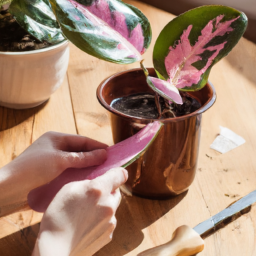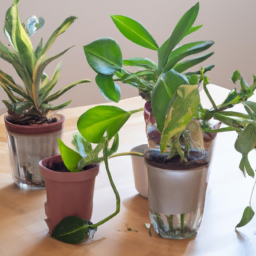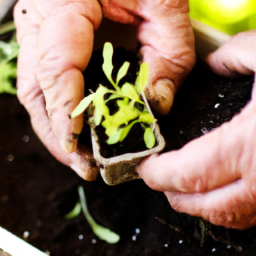
Understanding Plant Propagation Methods: A Comprehensive Guide
Introduction
Plant propagation is an essential skill for any gardener or plant enthusiast. It allows you to create new plants from existing ones, ensuring a continuous supply of your favorite species. Whether you want to expand your garden or share your plants with friends and family, mastering plant propagation techniques is the key to success. In this comprehensive guide, we will explore various methods of plant propagation and provide you with tips and techniques to ensure your success.
1. Seed Propagation
Seed propagation is the most common and basic method of plant propagation. It involves collecting seeds from mature plants and growing them into new ones. Here are the steps to successfully propagate plants from seeds:
Step 1: Seed Collection
Collect seeds from healthy and mature plants. Make sure the seeds are fully ripe and have dried properly. Avoid collecting seeds from weak or diseased plants as they may not produce healthy offspring.
Step 2: Seed Preparation
Clean the seeds by removing any debris or remaining fruit pulp. Some seeds may require scarification, which involves gently scratching or nicking the seed coat to promote germination. Soaking certain seeds in water overnight can also aid in germination.
Step 3: Sowing the Seeds
Plant the prepared seeds in a seed tray or individual pots filled with a well-draining potting mix. Make sure to provide adequate moisture and light conditions for germination. Follow the specific requirements of each plant species regarding planting depth and spacing.
Step 4: Seedling Care
Once the seeds have germinated, provide them with proper care. Ensure they receive sufficient light, water, and nutrients. Transplant the seedlings into larger pots or directly into the garden when they have developed a strong root system and are large enough to handle.
Step 5: Hardening Off
Before permanently planting the seedlings outdoors, gradually expose them to outdoor conditions over a period of time. This process, known as hardening off, helps the plants acclimate to the new environment and prevents transplant shock.
2. Stem Cutting Propagation
Stem cutting propagation is another popular method used to propagate a wide range of plants. It involves taking a cutting from a healthy, mature plant and encouraging it to develop roots and grow into a new plant. Follow these steps for successful stem cutting propagation:
Step 1: Cutting Selection
Select a healthy stem from the parent plant. The stem should be free from diseases, pests, and damage. Choose a stem that is semi-hardwood or hardwood, as these have a higher chance of rooting successfully.
Step 2: Cutting Preparation
Using a sharp and clean pair of pruning shears, make a clean cut just below a node. Remove any leaves from the lower portion of the cutting, leaving only a few leaves at the top. If the plant has large leaves, you can trim them to reduce water loss through transpiration.
Step 3: Rooting Hormone (optional)
Dip the cut end of the stem in a rooting hormone powder or gel. This helps stimulate root growth and increases the chances of successful rooting. While not always necessary, it can significantly improve the success rate, especially for more challenging plant species.
Step 4: Planting the Cutting
Insert the prepared cutting into a well-draining potting mix or a propagating medium such as perlite or vermiculite. Make sure to provide proper moisture and humidity levels to encourage root development. You can cover the cutting with a plastic bag or use a propagating tray with a clear plastic lid to create a mini greenhouse effect.
Step 5: Root Development
Place the cutting in a warm and bright location, but avoid direct sunlight. Mist the cutting regularly to maintain humidity and prevent it from drying out. After a few weeks, gently tug on the cutting to check for resistance, indicating root development.
3. Division Propagation
Division propagation is a method commonly used for plants that produce clumps or have multiple crowns. It involves dividing the plant into smaller sections, each with its own root system, and replanting them as individual plants. Here’s how to successfully propagate plants through division:
Step 1: Plant Selection
Choose a mature plant that has multiple crowns or clumps. This method is ideal for perennials such as hostas, daylilies, and ornamental grasses, which naturally develop clumps over time.
Step 2: Digging and Dividing
Carefully dig up the entire plant, ensuring you don’t damage the roots. Gently separate the clumps or crowns into smaller sections using a sharp knife or garden spade. Each divided section should have its own set of roots and foliage.
Step 3: Replanting
Plant each divided section in a suitable location, ensuring they have enough space to grow and thrive. Prepare the planting hole by loosening the soil and adding organic matter for improved drainage and fertility. Set the divided sections at the same depth they were originally planted.
Step 4: Post-division Care
Water the divided sections thoroughly after replanting to settle the soil and ensure good root-to-soil contact. Provide regular watering and monitor the plants for any signs of stress or wilting. Apply a layer of mulch to conserve moisture and suppress weed growth.
Step 5: Continued Care
Continue to care for the divided sections as you would for mature plants. Regularly water, fertilize, and monitor for pests and diseases. With proper care, the divided sections will establish themselves and grow into healthy, independent plants.
Conclusion
Mastering plant propagation techniques opens up a world of possibilities for gardeners and plant enthusiasts. Whether you prefer seed propagation, stem cutting propagation, or division propagation, each method has its own unique benefits and challenges. By understanding the steps involved and providing the necessary care, you can successfully propagate a wide variety of plants and expand your garden with ease. Remember, practice makes perfect, so don’t be discouraged if you encounter some failures along the way. With time and experience, you’ll become a master at propagating plants and enjoy the rewards of a thriving garden.

The Importance of Mastering Plant Propagation Techniques for Successful Gardening
Gardening is a rewarding and fulfilling hobby that allows individuals to connect with nature and create beautiful outdoor spaces. One crucial aspect of successful gardening is mastering plant propagation techniques. Plant propagation is the process of creating new plants from existing ones, and it is an essential skill for any gardener looking to expand their garden or share plants with others. In this article, we will explore the importance of mastering plant propagation techniques and provide you with a step-by-step guide to help you achieve success in this area.
Understanding the Benefits of Plant Propagation
There are several reasons why mastering plant propagation techniques is crucial for successful gardening. Firstly, it allows you to save money. Buying new plants from nurseries can be expensive, especially if you have a large garden or want to experiment with different plant varieties. By propagating your plants, you can create multiple copies from a single parent plant, saving you the cost of purchasing new ones.
Secondly, plant propagation gives you greater control over your garden. When you propagate plants, you have the freedom to choose which specific varieties you want to grow. This means you can select plants that are well-suited to your local climate, soil conditions, and personal preferences. Additionally, propagating your plants allows you to maintain a consistent quality in your garden, as you can ensure that the new plants are healthy and disease-free.
Lastly, mastering plant propagation techniques allows you to share your love for gardening with others. Propagating plants gives you the opportunity to give away or trade plants with friends, family, or fellow gardeners. It fosters a sense of community and allows you to connect with like-minded individuals who share your passion for plants.
Step-by-Step Guide to Mastering Plant Propagation Techniques
Now that we understand the importance of plant propagation, let’s dive into a step-by-step guide to help you master these techniques.
Step 1: Selecting the Parent Plant
The first step in plant propagation is selecting a healthy and suitable parent plant. Choose a plant that is disease-free, well-established, and exhibits desirable traits such as vibrant flowers or strong growth. It is essential to select a parent plant that is at its peak health and vigor to increase the chances of successful propagation.
Once you have chosen the parent plant, make sure to gather all the necessary tools and materials for the propagation process. These may include sharp pruning shears, rooting hormone, clean pots or containers, well-draining potting mix, and a misting bottle for watering.
Step 2: Choosing the Propagation Method
There are several different methods of plant propagation, including stem cuttings, leaf cuttings, division, layering, and seed propagation. Each method has its own advantages and is suitable for different types of plants. Research and choose the propagation method that best suits the plant you wish to propagate.
For example, stem cuttings are a popular method for propagating many flowering plants, herbs, and shrubs. Leaf cuttings, on the other hand, are commonly used for succulents and certain houseplants. Division is often used for perennials, while layering is suitable for plants with flexible branches.
Step 3: Preparing the Propagation Medium
Once you have chosen the propagation method, it’s time to prepare the propagation medium. The propagation medium is the material in which you will place the cutting or plant division to encourage root growth. It should be well-draining, sterile, and provide the right balance of moisture and air circulation.
Depending on the chosen method, you may need to prepare a rooting hormone solution to promote root development. Follow the instructions on the rooting hormone package carefully and mix it with water according to the recommended ratio.
Step 4: Taking the Cuttings or Divisions
Now that you have everything ready, it’s time to take the cuttings or divisions from the parent plant. Make sure to use clean and sharp pruning shears to minimize damage to the plant. Take the cuttings or divisions from healthy and non-flowering stems or sections of the parent plant.
Remove any leaves or flowers from the lower part of the cutting or division, as these can rot when placed in the propagation medium. Dip the cut end of the cutting or division into the rooting hormone solution (if using) and gently tap off any excess.
Step 5: Planting and Caring for the Propagated Plants
Once you have prepared the cuttings or divisions, it’s time to plant them in the propagation medium. Make a small hole in the medium using your finger or a dibber and carefully place the cutting or division into the hole. Gently firm the medium around the base of the cutting or division to ensure good contact.
After planting, water the propagated plants thoroughly and place them in an appropriate environment. Some plants may require bottom heat or higher humidity to encourage root growth. Monitor the moisture levels regularly and mist the plants if necessary to maintain the right level of humidity.
Step 6: Monitoring and Transplanting
Finally, it’s important to monitor the progress of your propagated plants and provide them with proper care. Check for signs of root growth, such as new shoots or increased firmness in the cuttings or divisions. Adjust the watering and environmental conditions as needed to ensure the plants thrive.
Once the propagated plants have developed strong root systems and are well-established, it’s time to transplant them into individual pots or directly into the garden. Handle the plants with care to avoid damaging the delicate roots, and provide them with the appropriate care and maintenance based on their specific plant requirements.
By following these step-by-step instructions and mastering plant propagation techniques, you can greatly enhance your gardening skills and create a thriving garden filled with beautiful and healthy plants. Remember to be patient and persistent, as plant propagation can sometimes be a trial-and-error process. Happy propagating!
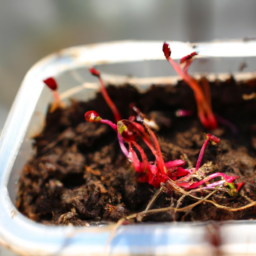
Tips and Tricks for Successful Plant Propagation: Mastering the Art
Introduction
Plant propagation is an art that allows us to create new plants from existing ones, whether through seeds, cuttings, or other methods. It is an essential skill for gardeners, horticulturists, and plant enthusiasts alike. Mastering plant propagation techniques can be a rewarding and fulfilling experience, enabling you to expand your plant collection, share your favorite plants with others, and even save money by growing your own plants from scratch. In this article, we will explore some valuable tips and tricks that will help you become a successful plant propagator.
1. Choosing the Right Method
Before diving into plant propagation, it is crucial to understand the various methods available and choose the one that best suits the plant species you wish to propagate. The most common methods include seed propagation, stem cuttings, leaf cuttings, division, layering, and grafting.
Each method has its own requirements and success rates. For example, some plants are easier to propagate from seeds, while others may require stem cuttings or grafting for better results. Research the specific plant species you are working with to determine the most suitable propagation method.
Additionally, consider the time of year and the stage of growth when selecting the method. Some plants may propagate more successfully during certain seasons or when they are actively growing. Understanding these factors will greatly increase your chances of success.
2. Preparing the Propagation Medium
The propagation medium plays a crucial role in the success of plant propagation. It provides the necessary support, moisture, and nutrients for the developing roots or shoots. Depending on the method chosen, different mediums may be used, such as soil, perlite, vermiculite, or a mixture of these.
Ensure that the propagation medium is well-draining to prevent waterlogging, which can lead to root rot. Sterilize the medium before use to eliminate any potential pathogens that may hinder successful propagation. This can be done by baking the medium in the oven or using a microwave.
Furthermore, consider adding rooting hormones to the propagation medium. Rooting hormones contain growth-promoting substances that stimulate root development and increase the chances of successful propagation. Follow the manufacturer’s instructions for the appropriate dosage and application method.
3. Proper Plant Care and Maintenance
Once you have selected the appropriate propagation method and prepared the propagation medium, it is essential to provide optimal care and maintenance to ensure successful plant propagation.
Ensure that the propagated plants receive the right amount of light. Some plants may require bright indirect light, while others may prefer shade or partial sun. Adjust the lighting conditions accordingly to prevent excessive stress or damage to the developing plants.
Consistent watering is crucial during the propagation process. Maintain a moist but not waterlogged environment to promote root development. Avoid overwatering, as it can lead to root rot, while underwatering can cause the plants to dry out and fail to establish roots.
Monitor the temperature and humidity levels as well. Most plants prefer a warm and humid environment during propagation. Consider using a propagation tray or a mini greenhouse to create the ideal conditions for successful plant propagation.
Conclusion
Plant propagation is a skill that can be mastered with practice, patience, and the right techniques. By choosing the appropriate propagation method, preparing the propagation medium correctly, and providing optimal care and maintenance, you can greatly increase your chances of successful plant propagation.
Remember, each plant species may have its own specific requirements, so it is essential to research and understand the needs of the plants you are working with. With time and experience, you will become a proficient plant propagator, expanding your plant collection and sharing the joy of growing new plants with others.
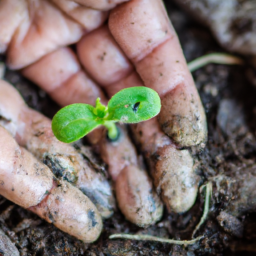
Exploring Advanced Plant Propagation Techniques for Garden Enthusiasts
Introduction
Gardening enthusiasts are always looking for new and advanced techniques to propagate plants successfully. Mastering plant propagation requires a deep understanding of various methods and tips that can help you achieve remarkable results. In this article, we will explore some advanced plant propagation techniques that will take your gardening skills to the next level. Whether you are a beginner or an experienced gardener, these techniques will provide you with valuable insights and tips for success.
Air Layering
Air layering is an advanced propagation technique that allows you to create new plants from existing ones without cutting them. This method is particularly useful for plants that are difficult to root from cuttings. Here’s how you can master air layering:
1. Select a healthy and mature branch of the plant you want to propagate. Make a small incision on the branch, about halfway through the stem.
2. Apply a rooting hormone to the incision to encourage root growth.
3. Surround the incision with moist sphagnum moss or a rooting medium of your choice.
4. Wrap the moss and the incision with plastic wrap, ensuring it is tightly sealed to create a humid environment.
5. Monitor the moisture level regularly and mist the moss if it starts to dry out.
6. After a few weeks, roots will start to form in the moss. Once the roots are well-developed, carefully cut the branch below the air layer and pot it in a suitable growing medium.
Air layering is an effective technique for propagating plants like citrus trees, magnolias, and camellias. It allows you to create new plants that are genetically identical to the parent plant, ensuring desirable traits are preserved.
Grafting
Grafting is a technique used to join two plant parts together, allowing them to grow as one. This method is commonly used to propagate fruit trees, roses, and other woody plants. Here’s a step-by-step guide to mastering grafting:
1. Select a healthy rootstock plant and a desired scion (the part you want to propagate) that are compatible with each other.
2. Make a clean and slanted cut on the rootstock, exposing the cambium layer.
3. Make a corresponding slanted cut on the scion, ensuring it matches the angle of the rootstock cut.
4. Join the two cuts together, aligning the cambium layers as closely as possible.
5. Secure the graft union with grafting tape or a grafting clip to prevent movement.
6. Protect the graft union by applying grafting wax or a similar sealant.
7. Place the grafted plant in a warm and humid environment, such as a propagator or a plastic bag, to encourage healing and growth.
8. After a few weeks, the graft union should start to heal, and new growth will emerge from the scion.
Grafting allows you to combine the desirable characteristics of different plants onto a single plant. It is an advanced technique that requires precision and practice, but the results can be truly rewarding.
Tissue Culture
Tissue culture is a laboratory-based propagation technique that involves growing plants from small tissue samples under sterile conditions. This method is particularly useful for propagating rare or endangered plants, as well as producing large quantities of plants with identical traits. Here’s how you can master tissue culture:
1. Start by collecting a small tissue sample from a healthy and disease-free plant.
2. Sterilize the tissue sample using bleach or another suitable disinfectant to remove any contaminants.
3. Place the sterilized tissue sample onto a nutrient-rich agar medium in a sterile container.
4. Seal the container and place it in a controlled environment with the right temperature and light conditions.
5. Monitor the growth of the tissue culture regularly and transfer it to fresh nutrient media as needed.
6. After a few weeks or months, the tissue culture will develop into small plantlets.
7. Transfer the plantlets to a suitable growing medium and acclimatize them to normal growing conditions.
Tissue culture allows you to propagate plants rapidly and efficiently, bypassing the traditional methods of seed germination or cuttings. It is a complex technique that requires specialized equipment and knowledge, but it can revolutionize the way plants are propagated.
Conclusion
Mastering plant propagation techniques is an exciting journey for garden enthusiasts. By exploring advanced methods like air layering, grafting, and tissue culture, you can expand your gardening skills and achieve remarkable results. Remember to practice patience and precision, as these techniques require careful attention to detail. Whether you want to create new plants from existing ones or propagate rare species, these advanced techniques will undoubtedly elevate your gardening experience to new heights. So, roll up your sleeves, gather your tools, and embark on the journey of mastering plant propagation!

Common Mistakes to Avoid in Plant Propagation: Expert Tips for Success
Plant propagation is a fascinating and rewarding process that allows you to create new plants from existing ones. Whether you are a seasoned gardener or just starting out, it’s important to be aware of common mistakes that can hinder your success in propagating plants. In this article, we will discuss five common mistakes to avoid and provide expert tips to help you achieve success in plant propagation.
1. Lack of Proper Planning and Preparation
One of the most common mistakes in plant propagation is a lack of proper planning and preparation. Before you start propagating plants, it’s essential to research and understand the specific requirements of the plant species you intend to propagate. This includes knowing the ideal propagation methods, timing, and environmental conditions.
Additionally, it’s crucial to gather all the necessary tools and materials before you begin. These may include rooting hormone, sterile potting mix, containers, and pruning shears. By being well-prepared, you can ensure a smooth and successful propagation process.
Furthermore, take the time to prepare the plants you wish to propagate. Properly prune and sanitize the parent plants to remove any diseased or damaged parts. This will increase the chances of propagating healthy and vigorous offspring.
2. Improper Timing
Timing plays a crucial role in plant propagation. Many gardeners make the mistake of propagating plants at the wrong time, leading to poor success rates. Each plant species has its own optimal time for propagation, which may vary based on factors such as the plant’s growth cycle and environmental conditions.
It’s essential to research and understand the specific timing requirements for the plant species you are propagating. Some plants may require propagation during the spring when they are actively growing, while others may prefer propagation during the dormant season. By following the appropriate timing, you can increase the chances of successful propagation.
Additionally, consider the weather conditions when propagating plants outdoors. Extreme temperatures or unfavorable weather conditions can negatively impact the success of propagation. If necessary, provide protection such as shade cloth or cold frames to create a suitable environment for the propagated plants.
3. Incorrect Propagation Techniques
Using incorrect propagation techniques is another common mistake that can hinder your success in plant propagation. Different plant species require specific propagation methods, such as stem cuttings, leaf cuttings, layering, or seed propagation.
It’s crucial to understand the appropriate propagation technique for the plant species you are working with. Research and learn about the specific requirements and techniques for each plant species to ensure successful propagation. For example, some plants may require the use of rooting hormone or bottom heat to stimulate root growth, while others may require scarification or stratification of seeds.
Furthermore, make sure to follow proper sterilization procedures when propagating plants. Using clean and sterile tools, containers, and potting mix will help prevent the spread of diseases and ensure the health of the propagated plants.
4. Inadequate Environmental Conditions
Providing the right environmental conditions is crucial for successful plant propagation. Many gardeners make the mistake of not providing the necessary light, temperature, and humidity levels required for optimal growth and root development.
When propagating plants indoors, ensure they receive adequate light. Place them near a window with bright, indirect light or use artificial grow lights to provide the necessary light energy for photosynthesis and healthy growth.
Temperature and humidity are also important factors to consider. Most plants prefer warm temperatures for successful propagation. However, it’s essential to research the specific temperature requirements for the plant species you are propagating, as some may require cooler temperatures or specific temperature fluctuations to stimulate root growth.
Humidity is particularly crucial during the initial stages of propagation when the plants are developing roots. To increase humidity, you can cover the propagated plants with a clear plastic bag or use a propagation tray with a transparent lid. This will create a mini greenhouse effect, maintaining high humidity levels and promoting root development.
5. Neglecting Proper Care and Monitoring
Once you have successfully propagated your plants, it’s important not to neglect their care and monitoring. Many gardeners make the mistake of assuming that propagation is the final step and fail to provide ongoing care.
Regularly check the propagated plants for signs of stress, pests, or diseases. Provide appropriate watering, ensuring the potting mix is moist but not waterlogged. Overwatering can lead to root rot, while underwatering can cause the plants to wither and die.
As the plants grow, consider transplanting them into larger containers to allow for proper root development. Fertilize the propagated plants with a balanced fertilizer to provide essential nutrients for healthy growth.
Furthermore, continue to monitor and adjust the environmental conditions as needed. As the propagated plants mature, they may require different light, temperature, or humidity levels. Stay attentive and make any necessary adjustments to ensure their continued success.
In conclusion, by avoiding these common mistakes and following expert tips, you can increase your success in plant propagation. Remember to plan and prepare adequately, propagate at the right time, use correct techniques, provide suitable environmental conditions, and give proper care and monitoring to your propagated plants. With patience, practice, and a little bit of knowledge, you can become a master of plant propagation and enjoy the satisfaction of creating new plants from existing ones.
Frequently Asked Questions (FAQ)
1. What is plant propagation?
Plant propagation refers to the process of creating new plants from existing ones. It involves various techniques to reproduce plants, such as seeds, cuttings, grafting, division, and layering.
2. Why is mastering plant propagation important?
Mastering plant propagation techniques is crucial for gardeners and horticulturists as it allows them to expand their plant collection, save money on buying new plants, and preserve rare or endangered species.
3. What are the different techniques for plant propagation?
There are several techniques for plant propagation, including seed sowing, stem cuttings, leaf cuttings, root cuttings, division, layering, and grafting. Each technique has its own requirements and benefits.
4. How do I choose the right propagation technique for a specific plant?
The choice of propagation technique depends on the type of plant, its growth habits, and the desired outcome. Some plants may be better suited for propagation through seeds, while others may require stem cuttings or grafting. Researching the specific plant’s propagation requirements is essential.
5. What are the essential tools and materials for plant propagation?
Common tools and materials for plant propagation include clean pots or trays, well-draining soil or growing medium, rooting hormone, sharp pruning shears or scissors, labels, and plastic bags or propagators for creating a humid environment.
6. How can I improve the success rate of plant propagation?
To increase the success rate of plant propagation, it is important to provide the right environmental conditions such as proper lighting, temperature, humidity, and watering. Using sterile tools, selecting healthy plant material, and following proper techniques also contribute to success.
7. Can I propagate plants indoors?
Absolutely! Many plants can be successfully propagated indoors. You can create a dedicated propagation area near a window with sufficient light or use grow lights to provide the necessary illumination.
8. How long does it take for propagated plants to root or germinate?
The rooting or germination time varies depending on the plant species and propagation technique used. Some plants may root or germinate within a few weeks, while others may take several months. Patience is key!
9. Are there any common mistakes to avoid during plant propagation?
Yes, some common mistakes to avoid include overwatering, using poor-quality or contaminated soil, not providing adequate light or warmth, not following proper techniques, and not monitoring the progress of propagated plants.
10. Where can I find more information on mastering plant propagation?
There are numerous resources available, including books, online articles, gardening forums, and videos, that provide detailed information on plant propagation techniques and tips. You can also consult local horticultural societies or visit botanical gardens for hands-on learning experiences.
Dr. Olivia Green is a botanist with over two decades of experience in indoor plant cultivation. She holds a Ph.D. in Plant Biology and has dedicated her career to researching plant behavior in controlled environments. Dr. Green is passionate about helping plant enthusiasts master the art of indoor gardening through her extensive knowledge and practical insights.

